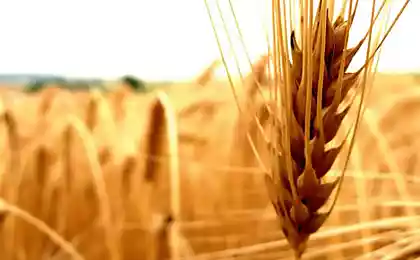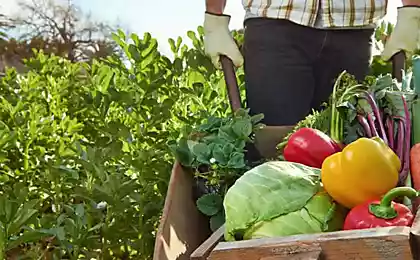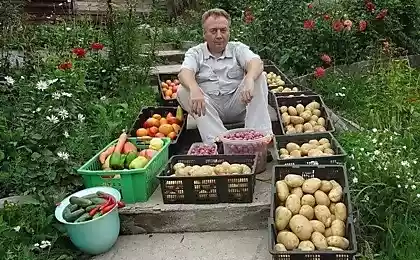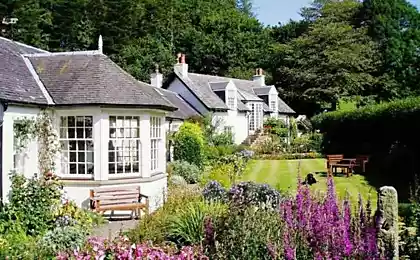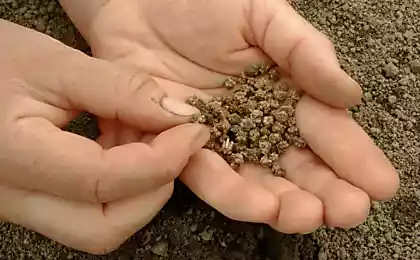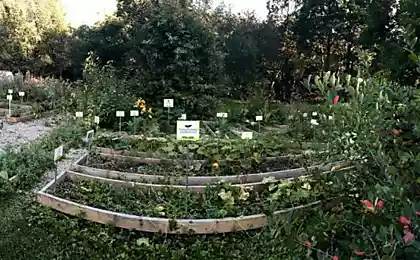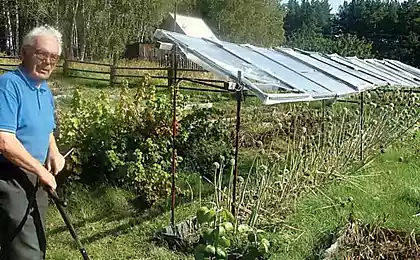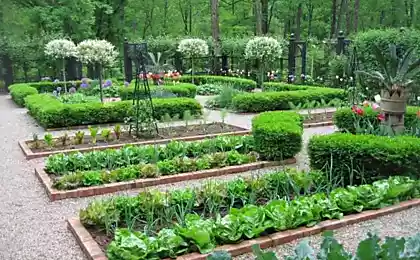211
From personal experience: unsolved sowing
As soon as I got to know my neighbors in the spring, each of them told me to smell their land. The fact is that the thunderstorm of local gardeners - a weed named wheatgrass - reigns supreme in the plots. With its strong roots, it penetrates the upper layer of the earth 15-20 cm and, as it is believed, does not allow anything else to grow. Therefore, every year the villagers drive a tractor to their plot, it plows all the land, then people manually select wheatgrass roots from an earthen dump and burn them. The more carefully the roots are selected, the cleaner the land and, accordingly, the more time it will take for wheatgrass to develop this territory in the summer. In the meantime, it will restore the status quo, the beds of cultivated plants will have time to grow. Anyway, life is a struggle. 
My timid excuses that, they say, I have my own technology, that I will be in my own way, not only met with objections, but simply were not perceived. My conversations just shook the air. I understand them: he comes to the village and says that he will not do like everyone else.
In vain.The next move from the villagers is that if you do not plow the field, then it walks, and if it walks, we will walk around your plot and herd our cows there. All this resulted in a sharp confrontation with the locals. The birch trees planted along the border told them nothing. Only a hastily put wooden fence fence fence fenced off my plot from being trampled by cows. But people are still walking. But over time, I hope to wean them off.
Experiences
I prepared the first plots for planting as follows: I took a boot (I don’t have flatbed) and carefully cut down all the weed stems from the site, without touching the roots. Then he covered a layer of forest mulch (in one case, having previously covered the ground with old newspapers, in another - without them).
Honestly, I still don't understand why you need to put dung and mulch on top of cardboard or newspapers. After all, in this case, manure does not touch the earth, cannot become part of it. So I later abandoned this scheme.
All these simple procedures I did with some carelessness, and the wheatgrass immediately used my holes. First, I didn't completely enclose the sites with dug-in boards, and the weeds came very quickly from the unprotected sides. Well, second.A simple cutting of the stems and a thick layer of mulch was not enough to deprive the weed of strength. The wheatgrass made its way through newspapers and forest mulch very vividly.The first important discovery: Those weeds that did not manage to make their way to the top, really stinked and rotted. When I looked under the mulch newspaper a week later, I saw (wonderful!) that many weeds lay on the ground, pale, poorly developed, without any strength.And the second discovery: In the midday heat, the ground was cool and wet. So the principle worked, simple and stunning. We could have moved on.
On my plots, peas, beans, soybeans, sunflowers have grown perfectly. These plants were even stronger than wheatgrass, which made its way up from under mulch. I was just 3 weeks away, going on vacation, but my landing was not affected. That is, although some weeds survived and made their way, but, as in that joke, their health is still not what it was. However, almost all spicy herbs disappeared - here the wheatgrass defeated them.
So, you need to be careful in fenced off and darkened areas.
I did another experiment: He took an old newspaper, picked weeds on a small patch and put a newspaper there, sprinkled earth on top. In the middle of the newspaper he cut a small hole, in this place he made a small hole in the ground with his fingers, stuck a sunflower seed into the ground and poured water. Once 2-3 watered - the sunflower grew. When it was 20 to 30 cm high, there were no weeds around, I took a newspaper off the ground and let it grow further in the midst of catching weeds. There are good sunflowers, delicious seeds.
Conclusion: There is some critical dimming point, beyond which there is a practically safe zone, weeds will not rise. In my last example: A fourfold newspaper and a 3-5 cm layer of earth were effective for about a month. I think there is a critical level for every weed environment, and it’s easy to learn from experience.
However, at the end of August I thought: why not use this amazing survivability of wheat. He is not the enemy of the earth, he is simply more effective than others in fastening the earth and keeping it from the drying rays of the summer sun. Thank you to him, ferment. If he's so good, he'll help us with this.
Cheese weed hero

I was always upset when I dug holes in the ground: the top layer of 15-20 cm is a dense layer of roots of wheatgrass and other weeds, between which is sandy earth, and under this layer is just sand. I think it's a pretty barren land. How to make the layer of the rooted earth thicker? After all, then, darkening, you can organize more rotting roots and, accordingly, water and air channels in the soil.
Now imagine: We dig a hole with a depth of 30-40 cm, a layer of wheat with stems and roots (these upper 15-20 cm) we fold in one direction, the rest of the earth in the other. Then we throw a layer of wheatgrass to the bottom and fill the wheatgrass with a layer of earth, obviously thinner than the critical level I wrote about above. The wheatgrass, of course, easily penetrates it and quickly develops the territory. What if we put the land on the ground again? I suspect the cowboy will repeat his feat.
And here, after the second feat of wheatgrass, we make a crown move: We take and cover this whole sandwich with dense cardboard or rags, reaching a critical level of blackout.
Guess what happens.
Right, a layer of earth soaked in rotting stems and weed roots, with a layer thicker than under normal conditions. For fidelity (if you doubt the strength of your weeds), after the next powder, you can sow something to the weeds (for example, clover, alfalfa, corn, peas, sunflowers). Something will definitely come up. There is a suspicion that this sandwich will be more useful than a natural one. And if you throw compost here, you want to shout: Spring, come quickly, I want to plant plants!
I have not yet tested the above idea, because I came to it late. Maybe there is something more effective, but at least I will try it.
Permaculture or not permaculture
I will make a small theoretical digression here. The ideas that Kurdyumov expressed in his books are largely creative. I hope that it is the creative and careful agriculture he describes that is the future. But I think his ideas need to be approached creatively and meaningfully.
Here he writes about gardeners-organists: the land is not suitable for cultivation of valuable vegetables. That is why they create a layer of rich organics, in which they grow vegetables with great profit for themselves.
My idea is that growing vegetables with great productivity on enriched soils or created soil layers, we must not forget about natural, earthly agriculture, the image of which so ignites.
Enough theory!
It is with great pleasure that I can state: In the unsatisfactory land (by that time the humus had not yet ripened), in the unplowed land, on the land in which all the roots of weeds remained, on an unfertile land like mine, you can grow beautiful fruits. At least I had plenty of peas and seeds. And what delicious young ears of corn, when you eat them completely, with swings, raw! Sweet tooth dream! And this is with a minimum of labor: Cover the ground, prune nearby weeds early in plant development - and eat, please!

Finally, I will tell you another way to prepare beds according to Kurdyumov (with sideration). I cut down all the weed stems on the site with a boot, carefully enclose the site with dug up boards. I’m filling the area with a layer of rotten manure (it’s finally ripe). Sowing seeds: in one case a mixture of alfalfa, clover, sunflower, corn, peas; in another - winter rye. Plenty of watering, cover with a thin layer of cut grass. After 3-4 layers of grass, let the sprouts eat the sun. After a week, we have another dense green carpet of weeds not to see (cutting, a thick layer of humus and planted plants suppressed them).
I cut off all this wealth (to be honest, it was a pity – it looks so beautiful), I put it on the site, cover it with old rags, sprinkle it with earth. I'll open it in spring. By the way, in the case of winter rye, after I cut the sprouts, I covered them with a second layer of humus and sowed the rye again. When she grows up, I will cut her off and also cover her - let her lament. The result is a fertile layer thicker.published by P.S. And remember, just changing our consumption – together we change the world!
Join us on Facebook, VKontakte, Odnoklassniki
Source: vedamost-zemledelie.blogspot.com/2016/03/blog-post.html#more

My timid excuses that, they say, I have my own technology, that I will be in my own way, not only met with objections, but simply were not perceived. My conversations just shook the air. I understand them: he comes to the village and says that he will not do like everyone else.
In vain.The next move from the villagers is that if you do not plow the field, then it walks, and if it walks, we will walk around your plot and herd our cows there. All this resulted in a sharp confrontation with the locals. The birch trees planted along the border told them nothing. Only a hastily put wooden fence fence fence fenced off my plot from being trampled by cows. But people are still walking. But over time, I hope to wean them off.
Experiences
I prepared the first plots for planting as follows: I took a boot (I don’t have flatbed) and carefully cut down all the weed stems from the site, without touching the roots. Then he covered a layer of forest mulch (in one case, having previously covered the ground with old newspapers, in another - without them).
Honestly, I still don't understand why you need to put dung and mulch on top of cardboard or newspapers. After all, in this case, manure does not touch the earth, cannot become part of it. So I later abandoned this scheme.
All these simple procedures I did with some carelessness, and the wheatgrass immediately used my holes. First, I didn't completely enclose the sites with dug-in boards, and the weeds came very quickly from the unprotected sides. Well, second.A simple cutting of the stems and a thick layer of mulch was not enough to deprive the weed of strength. The wheatgrass made its way through newspapers and forest mulch very vividly.The first important discovery: Those weeds that did not manage to make their way to the top, really stinked and rotted. When I looked under the mulch newspaper a week later, I saw (wonderful!) that many weeds lay on the ground, pale, poorly developed, without any strength.And the second discovery: In the midday heat, the ground was cool and wet. So the principle worked, simple and stunning. We could have moved on.
On my plots, peas, beans, soybeans, sunflowers have grown perfectly. These plants were even stronger than wheatgrass, which made its way up from under mulch. I was just 3 weeks away, going on vacation, but my landing was not affected. That is, although some weeds survived and made their way, but, as in that joke, their health is still not what it was. However, almost all spicy herbs disappeared - here the wheatgrass defeated them.
So, you need to be careful in fenced off and darkened areas.
I did another experiment: He took an old newspaper, picked weeds on a small patch and put a newspaper there, sprinkled earth on top. In the middle of the newspaper he cut a small hole, in this place he made a small hole in the ground with his fingers, stuck a sunflower seed into the ground and poured water. Once 2-3 watered - the sunflower grew. When it was 20 to 30 cm high, there were no weeds around, I took a newspaper off the ground and let it grow further in the midst of catching weeds. There are good sunflowers, delicious seeds.
Conclusion: There is some critical dimming point, beyond which there is a practically safe zone, weeds will not rise. In my last example: A fourfold newspaper and a 3-5 cm layer of earth were effective for about a month. I think there is a critical level for every weed environment, and it’s easy to learn from experience.
However, at the end of August I thought: why not use this amazing survivability of wheat. He is not the enemy of the earth, he is simply more effective than others in fastening the earth and keeping it from the drying rays of the summer sun. Thank you to him, ferment. If he's so good, he'll help us with this.
Cheese weed hero

I was always upset when I dug holes in the ground: the top layer of 15-20 cm is a dense layer of roots of wheatgrass and other weeds, between which is sandy earth, and under this layer is just sand. I think it's a pretty barren land. How to make the layer of the rooted earth thicker? After all, then, darkening, you can organize more rotting roots and, accordingly, water and air channels in the soil.
Now imagine: We dig a hole with a depth of 30-40 cm, a layer of wheat with stems and roots (these upper 15-20 cm) we fold in one direction, the rest of the earth in the other. Then we throw a layer of wheatgrass to the bottom and fill the wheatgrass with a layer of earth, obviously thinner than the critical level I wrote about above. The wheatgrass, of course, easily penetrates it and quickly develops the territory. What if we put the land on the ground again? I suspect the cowboy will repeat his feat.
And here, after the second feat of wheatgrass, we make a crown move: We take and cover this whole sandwich with dense cardboard or rags, reaching a critical level of blackout.
Guess what happens.
Right, a layer of earth soaked in rotting stems and weed roots, with a layer thicker than under normal conditions. For fidelity (if you doubt the strength of your weeds), after the next powder, you can sow something to the weeds (for example, clover, alfalfa, corn, peas, sunflowers). Something will definitely come up. There is a suspicion that this sandwich will be more useful than a natural one. And if you throw compost here, you want to shout: Spring, come quickly, I want to plant plants!
I have not yet tested the above idea, because I came to it late. Maybe there is something more effective, but at least I will try it.
Permaculture or not permaculture
I will make a small theoretical digression here. The ideas that Kurdyumov expressed in his books are largely creative. I hope that it is the creative and careful agriculture he describes that is the future. But I think his ideas need to be approached creatively and meaningfully.
Here he writes about gardeners-organists: the land is not suitable for cultivation of valuable vegetables. That is why they create a layer of rich organics, in which they grow vegetables with great profit for themselves.
My idea is that growing vegetables with great productivity on enriched soils or created soil layers, we must not forget about natural, earthly agriculture, the image of which so ignites.
Enough theory!
It is with great pleasure that I can state: In the unsatisfactory land (by that time the humus had not yet ripened), in the unplowed land, on the land in which all the roots of weeds remained, on an unfertile land like mine, you can grow beautiful fruits. At least I had plenty of peas and seeds. And what delicious young ears of corn, when you eat them completely, with swings, raw! Sweet tooth dream! And this is with a minimum of labor: Cover the ground, prune nearby weeds early in plant development - and eat, please!

Finally, I will tell you another way to prepare beds according to Kurdyumov (with sideration). I cut down all the weed stems on the site with a boot, carefully enclose the site with dug up boards. I’m filling the area with a layer of rotten manure (it’s finally ripe). Sowing seeds: in one case a mixture of alfalfa, clover, sunflower, corn, peas; in another - winter rye. Plenty of watering, cover with a thin layer of cut grass. After 3-4 layers of grass, let the sprouts eat the sun. After a week, we have another dense green carpet of weeds not to see (cutting, a thick layer of humus and planted plants suppressed them).
I cut off all this wealth (to be honest, it was a pity – it looks so beautiful), I put it on the site, cover it with old rags, sprinkle it with earth. I'll open it in spring. By the way, in the case of winter rye, after I cut the sprouts, I covered them with a second layer of humus and sowed the rye again. When she grows up, I will cut her off and also cover her - let her lament. The result is a fertile layer thicker.published by P.S. And remember, just changing our consumption – together we change the world!
Join us on Facebook, VKontakte, Odnoklassniki
Source: vedamost-zemledelie.blogspot.com/2016/03/blog-post.html#more


